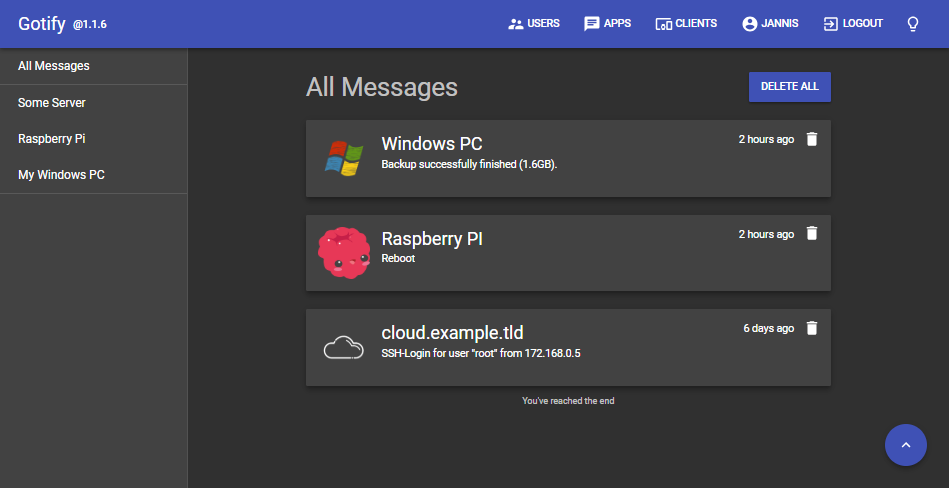|
|
||
|---|---|---|
| api | ||
| auth | ||
| config | ||
| database | ||
| docker | ||
| docs | ||
| error | ||
| mode | ||
| model | ||
| router | ||
| runner | ||
| test | ||
| ui | ||
| .gitignore | ||
| .travis.yml | ||
| ADD_MESSAGE_EXAMPLES.md | ||
| CODE_OF_CONDUCT.md | ||
| Gopkg.lock | ||
| Gopkg.toml | ||
| LICENSE | ||
| Makefile | ||
| README.md | ||
| app.go | ||
| docker-push.sh | ||
| logo.png | ||
| ui.png | ||
README.md
Gotify Server

- Motivation
- Features
- Installation
- Configuration
- Push Message Examples
- Setup Dev Environment
- Building
- Tests
- Versioning
- License
Motivation
We wanted a simple server for sending and receiving messages (in real time per web socket). For this, not many open source projects existed and most of the existing ones were abandoned. Also, a requirement was that it can be self-hosted. We know there are many free and commercial push services out there.
Features

- send messages via REST-API
- receive messages via web socket
- manage users, clients and applications
- API Docs (also available at
/docs) - Web-UI -> ./ui
- CLI for sending messages -> gotify/cli
- Android-App -> gotify/android
Google Play and the Google Play logo are trademarks of Google LLC.
Installation
Docker
The docker image is available on docker hub at gotify/server.
$ docker run -p 80:80 -v /etc/gotify/data:/app/data gotify/server
Also there is a specific docker image for arm-7 processors (raspberry pi), named gotify/server-arm7.
$ docker run -p 80:80 -v /etc/gotify/data:/app/data gotify/server-arm7
/app/data contains the database file (if sqlite is used), images for applications and cert-files (if lets encrypt is enabled).
Binary
Visit the releases page and download the zip for your OS.
Configuration
File
When strings contain reserved characters then they need to be escaped. List of reserved characters and how to escape them.
server:
port: 80 # the port for the http server
ssl:
enabled: false # if https should be enabled
redirecttohttps: true # redirect to https if site is accessed by http
port: 443 # the https port
certfile: # the cert file (leave empty when using letsencrypt)
certkey: # the cert key (leave empty when using letsencrypt)
letsencrypt:
enabled: false # if the certificate should be requested from letsencrypt
accepttos: false # if you accept the tos from letsencrypt
cache: data/certs # the directory of the cache from letsencrypt
hosts: # the hosts for which letsencrypt should request certificates
- mydomain.tld
- myotherdomain.tld
responseheaders: # response headers are added to every response (default: none)
Access-Control-Allow-Origin: "*"
Access-Control-Allow-Methods: "GET,POST"
database: # for database see (configure database section)
dialect: sqlite3
connection: data/gotify.db
defaultuser: # on database creation, gotify creates an admin user
name: admin # the username of the default user
pass: admin # the password of the default user
passstrength: 10 # the bcrypt password strength (higher = better but also slower)
uploadedimagesdir: data/images # the directory for storing uploaded images
Environment
Escaped characters in list or map environment settings (GOTIFY_SERVER_RESPONSEHEADERS and
GOTIFY_SERVER_SSL_LETSENCRYPT_HOSTS) need to be escaped as well.
List of reserved characters and how to escape them.
GOTIFY_SERVER_PORT=80
GOTIFY_SERVER_SSL_ENABLED=false
GOTIFY_SERVER_SSL_REDIRECTTOHTTPS=true
GOTIFY_SERVER_SSL_PORT=443
GOTIFY_SERVER_SSL_CERTFILE=
GOTIFY_SERVER_SSL_CERTKEY=
GOTIFY_SERVER_SSL_LETSENCRYPT_ENABLED=false
GOTIFY_SERVER_SSL_LETSENCRYPT_ACCEPTTOS=false
GOTIFY_SERVER_SSL_LETSENCRYPT_CACHE=certs
# lists are a little weird but do-able (:
GOTIFY_SERVER_SSL_LETSENCRYPT_HOSTS=- mydomain.tld\n- myotherdomain.tld
GOTIFY_SERVER_RESPONSEHEADERS="Access-Control-Allow-Origin: \"*\"\nAccess-Control-Allow-Methods: \"GET,POST\""
GOTIFY_DATABASE_DIALECT=sqlite3
GOTIFY_DATABASE_CONNECTION=gotify.db
GOTIFY_DEFAULTUSER_NAME=admin
GOTIFY_DEFAULTUSER_PASS=admin
GOTIFY_PASSSTRENGTH=10
GOTIFY_UPLOADEDIMAGESDIR=images
Database
| Dialect | Connection |
|---|---|
| sqlite3 | path/to/database.db |
| mysql | gotify:secret@/gotifydb?charset=utf8&parseTime=True&loc=Local |
| postgres | host=localhost port=3306 user=gotify dbname=gotify password=secret |
When using postgres without SSL then sslmode=disable must be added to the connection string.
See #90.
Push Message Examples
You can simply use curl, HTTPie or any other http-client to push messages.
An application-token can be obtained from the apps tab inside the UI or using the REST-API (/application).
$ curl -X POST "https://push.example.de/message?token=<apptoken>" -F "title=my title" -F "message=my message"
$ http -f POST "https://push.example.de/message?token=<apptoken>" title="my title" message="my message"
More examples can be found here
Also you can use gotify/cli to push messages. The CLI stores url and token in a config file.
$ gotify push -t "my title" -p 10 "my message"
$ echo my message | gotify push
Setup Dev Environment
Setup Server
Download go dependencies with golang/dep.
$ dep ensure
Run golang server.
$ go run app.go
Setup UI
Commands must be executed inside the ui directory.
Download dependencies with npm.
$ npm install
Star the UI development server.
$ npm start
Open http://localhost:3000 inside your favorite browser.
The UI requires a Gotify server running on localhost:80 this can be adjusted inside the ui/src/index.tsx.
Building
Build Server
$ go build app.go
Build UI
$ npm run build
Cross-Platform
The project has a CGO reference (because of sqlite3), therefore a GCO cross compiler is needed for compiling for other platforms. See .travis.yml on how we do that.
Tests
The tests can be executed with:
$ make test
# or
$ go test ./...
Versioning
We use SemVer for versioning. For the versions available, see the tags on this repository.
License
This project is licensed under the MIT License - see the LICENSE file for details




